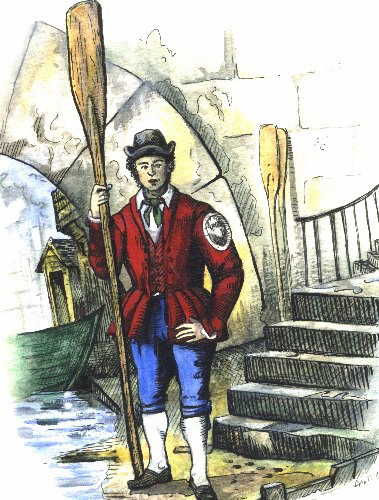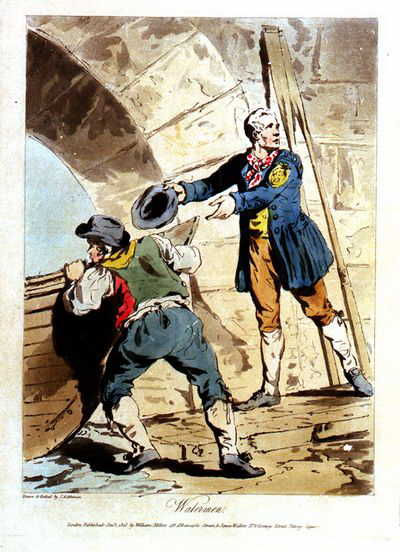Wapping Old Stairs
- noellb

- Mar 3
- 6 min read
Updated: Mar 9
The river Thames has played an intricate part in the history of London, England, and equally in the lives of our ancestors over generations. This iconic waterway, winding its way through the heart of the capital, has been a silent witness to the ebb and flow of human activity, culture, and development. From its origins in the Cotswolds, the Thames has journeyed through a landscape that has evolved dramatically over the centuries, shaping not only the geography but also the very fabric of society that surrounds it. The river's banks have seen the rise and fall of empires, the birth of innovations, and the unfolding of countless stories that have contributed to the rich tapestry of British heritage.

The river served to defend against foreign naval invasions in hostile times, acting as a formidable barrier that protected the city from potential threats. Its strategic position made it a critical line of defence during various conflicts, including the threat posed by the Spanish Armada in the late 16th century and later during the world wars. The Thames was not merely a physical boundary; it was a symbol of resilience and strength for the people of London, who relied on it for protection and sustenance. Furthermore, the river facilitated the movement of troops and supplies, ensuring that the city could withstand sieges and assaults, thus playing a crucial role in the national security of the United Kingdom.
In contrast, during peaceful times, the Thames became a vital artery for commerce and trade, fostering the prosperity of the United Kingdom. The river served as a bustling highway for ships carrying goods from far-flung corners of the globe, transforming London into a thriving metropolis. Markets sprang up along its banks, and wharves became the bustling hubs of economic activity, where merchants engaged in the exchange of everything from spices to textiles. The growth of shipbuilding and the maritime industry further contributed to the economic landscape, providing jobs and livelihoods for countless individuals and families. The Thames, therefore, not only served as a means of transportation but also as a catalyst for innovation and growth, enabling the rise of London as one of the world's leading financial centres.
Our Bond family ancestors, along with the extended family members who form the rich tapestry of our lineage, have reaped the benefits of generations marked by employment opportunities and financial prosperity. This success can be traced back to their industrious endeavours in various fields closely tied to the Thames River, a vital artery of commerce and trade that has shaped the economic landscape of London for centuries.
Throughout the years, our family has been deeply intertwined with the river, engaging in a diverse array of professions that include Watermen and Lightermen, as well as Merchants and Shipbuilders. The Watermen, skilled navigators of the Thames, played a crucial role in the transportation of goods and passengers alike, expertly maneuvering their boats through the bustling waters of the city. Their knowledge of the river’s currents and tides was invaluable, allowing them to provide essential services that kept the flow of commerce alive and thriving.
In addition to the Watermen, our ancestors also included Lightermen, who were responsible for the loading and unloading of cargo from larger ships moored in the river. This job was not only physically demanding but also required a keen understanding of logistics and timing, as the success of many businesses depended on the efficient transfer of goods. The Lightermen’s work ensured that markets were stocked and trade flourished, contributing significantly to the economic vitality of London.
Moreover, our family history is rich with the legacy of Merchants who capitalized on the strategic location of the Thames River. These enterprising individuals engaged in importing and exporting a wide variety of goods, from textiles to spices, thereby linking London to distant markets across the globe. Their ability to navigate the complexities of international trade laid the foundation for financial success that would benefit generations to come.
Equally important are the Shipbuilders in our lineage, who utilized the resources available along the Thames to construct vessels that would serve both commercial and military purposes. The craftsmanship and engineering skills of these shipbuilders were paramount in creating sturdy ships that could withstand the challenges of the sea, thereby enhancing trade capabilities and bolstering the maritime economy of the region.
In summary, the Bond family’s connection to the Thames River is not just a footnote in our history; it is a cornerstone of our identity. The interplay of professions related to the river has not only shaped our family’s economic fortunes but has also woven a narrative of resilience, adaptability, and enterprise that has been passed down through generations. Each member of our family, from the Watermen navigating the river’s waters to the Merchants trading goods, has contributed to a legacy that continues to resonate within our family today. The Thames River, with its rich history and significance, remains a symbol of our family’s enduring connection to the past and a testament to the hard work and dedication of our ancestors.
The Wapping Old Stairs on the Northern Bank of the Thames conjure a nostalgic, romantic charm for me as I explore my family's past, but first, a bit of history about these old stairs that have borne witness to centuries of life along the river. These stairs, steeped in history, are not merely a functional descent to the water's edge; they are a portal to a bygone era, a time when the Thames was the lifeblood of London, bustling with trade, intrigue, and the darker aspects of human endeavour.
The stairs are simply a set of old, weathered steps leading down from Wapping High Street to the Thames River bank. They are accessed through a short, narrow alleyway that runs alongside the Town of Ramsgate Pub, a local establishment that has likely served countless patrons over the years. As we approach the stairs, we can almost feel the echoes of the past surrounding us, the whispers of those who once traversed these very steps, each carrying their own stories and secrets. The worn stones beneath our feet tell tales of travellers, merchants, and perhaps even those with less noble intentions, all of whom have left their mark on this historic site.

Records indicate that these old stairs existed well before the 16th century, making them a significant landmark in the history of Wapping. It is believed that they may have been the very stairs used by condemned pirates taking their last steps to the gallows at Execution Dock, a grim yet fascinating part of maritime history. This dock was notorious for its role in the punishment of those who dared to defy the law of the sea, and the sight of these stairs must have been a chilling reminder of the fate that awaited many a sailor who strayed into the realm of piracy.
For over 400 years, the north shore at Execution Dock became a site of grim notoriety, where pirates, smugglers, and mutineers met their end. The last hanging took place in 1830, marking the end of an era that had seen countless individuals brutally face justice. The haunting legacy of these hangings lingers in the air as if the spirits of those who perished still roam the area, reminding us of the harsh realities of life and death during that tumultuous time.

The old stone stairs also served a more practical purpose, acting as a pick-up and drop-off point for light goods and paying passengers who sought an easy transfer to the opposite river bank. This aspect of the stairs highlights their role in the vibrant trade and transportation network that characterised the Thames during its height. Our Watermen ancestors, skilled boatmen who navigated the river, may have used these Wapping Old Stairs to land or receive light cargo, pick up paying passengers, or, as historical records reveal, run the odd smuggling ring, adding a layer of intrigue to their daily operations. The bustling activity at these stairs would have painted a vivid picture of life along the Thames, where commerce thrived, and the river served as a vital artery connecting various parts of London.
Our Thames Watermen and Lightermen.
Source: Binding Records 1692-1949
Bond, William.
Bound year: 19th Mar 1789.
Where from: St. Catherines.
Master's name: William Spooner.
Date Free: 10 Dec 1801.
Bond, John Acton.
Bound year: 13 Oct 1803.
Where from: Greenwich.
Master's name: Thomas Rice.
Date free: 18th Apr 1811.
Bond, William Robert.
Bound year: 23rd Oct 1817.
Where from: Bermondsey.
Master's name: John White.
Date free: 11th Nov 1824.
Bond, Richard.
Bound year: 4th Jul 1818.
Where from: St. Catherines.
Master's name: Samuel Bond.
Date free: 23rd Jul 1825.
Bond, Charles Acton.
Bound year: 10th Feb1853.
Where from: Bermondsey.
Master's name: William Robert Bond.
Date free: America.
Bond, Henry.
Bound year: 10th Aug1860.
Where from: Bermondsey.
Master's name: William Robert Bond:
Date free: 10th Sep1867.
Bond, William.
Bound year: 13th Apr1854.
Where from: St. Georges in the East.
Master's name: Steers James Bond.
Date Free: 00-00-00.
Bond, William Thomas.
Bound year: 12th Nov 1840.
Where from: Bermondsey.
Master's name: Bond, William Robert.
Date free: 09 Dec 1847.
Bond, George.
Bound year:13th Jan1848.
Where from: Bermondsey
Master's name: Bond William Thomas.
Date free:14 Jun 1855
Bond, James Robert
Bound year:13th Mar1845
Where from: Bermondsey
Master's name: Bond, William Robert.
Date free:14 Jul 1853

Further Reading:
River Thames Watermen & Lightermen Apprenticeship Bidding 1861- 1908,
by Robbie Cottrell.
The Thames: England's River by Johnathan Schneer.
The Historic Thames by Hilaire Belloc.
Copyright © Noel Bond. Researched and written by Noel Bond, No written part of this Blog may be reproduced in any form, by any electronic or mechanical means, including information storage and retrieval systems, without written permission from the author.




Comments